Table of Contents
Pharmacy Equipment and Accessories : Preparing and dispensing remedies as well as medical advice for centuries

- Bunsen Burner Bowl
- PH301
-
- Early 20th century ceramic bunsen burner bowl. The bowl is approximately 2 inches deep. The top rim has a small spout molded into it for pouring. The bowl is glazed on both the inside and the outside with the inside glaze going not quite to the to... View Full Record
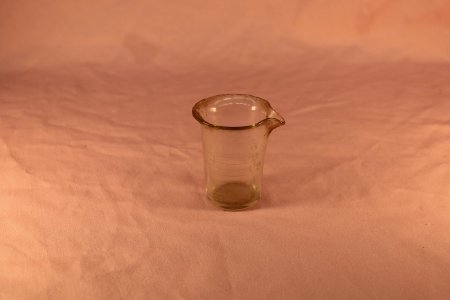
- Beaker
- PH302
-
- 19th century graduated pharmacy beaker. Lines and measurements are etched into the outside glass in increments of 1/4, 1/2, 1, 11/2, and 2 oz. The beaker is made from hand blown glass with a smooth bottom and a pouring spout formed into the top rim... View Full Record
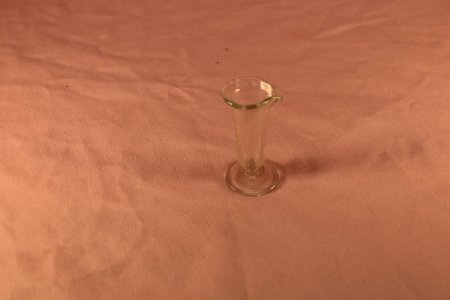
- graduate
- PH303
-
- Small early to mid 19th century clear glass graduate. This graduate is made from hand blown glass with a pouring spout formed into the top lip. The bottom of the graduate has a rough, dimpled pontil.
Measurements are hand etched onto the side wi... View Full Record

- graduate
- PH304
-
- Small glass graduate. Hand blown glass with smooth pontil. The lip at the top has a small pouring spout formed into it. There are no etchings or markings on the glass.
Base of the graduate measures 1.75 inches across while the top measures only... View Full Record
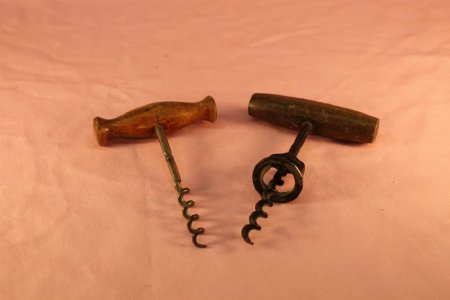
- Corkscrew
- PH309
-
- 2 pharmacy corkscrews with wooden handles. Both date to the mid to late 19th century. Pharmacists used cordscrews to open medicine bottles. These corkscrews measure just over 5 inches long and would have been used for the opening of larger medicin... View Full Record
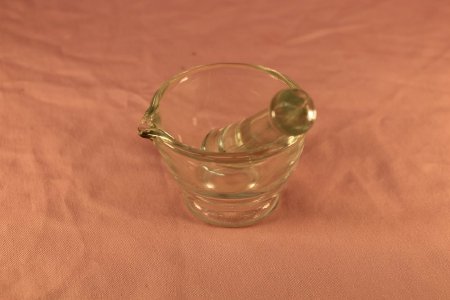
- Mortar & Pestle
- PH305
-
- Small glass mid 19th century mortar and pestle. It is made from machine blown clear glass. The top of the mortar has a pouring spout molded into it. Molded into the bottom of the mortar reads 2 OZ MADE IN US. The pestle has a number 2 molded int... View Full Record
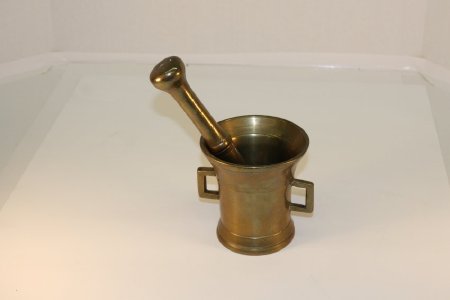
- Mortar & Pestle
- PH347
-
- Mid to late 19th century brass Mortar and Pestle.
Mortar has no visible mold seam indicating that it was manufactured after 1840. Although many crafters of brass implements polished out the seam to make them less visible, there is not even a slig... View Full Record
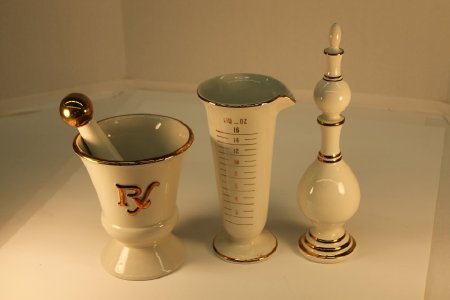
- Mortar & Pestle
- PH348
-
- Mid 20th century mortar and pestle display set. The set includes an ivory colored ceramic mortar and pestle, graduate and show globe all four pieces have gold accents. This type of ceramic set was typically used for decorative purposes and given to... View Full Record
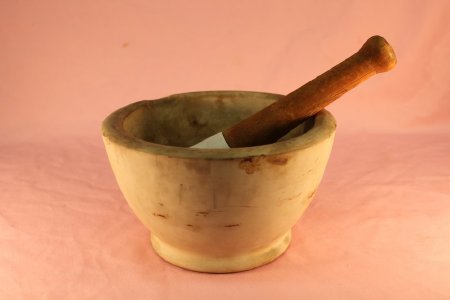
- Mortar & Pestle
- PH306
-
- Early 19th century mortar and pestle. The mortar is made of ceramic with the pestle made of porcelain and wood.
... View Full Record
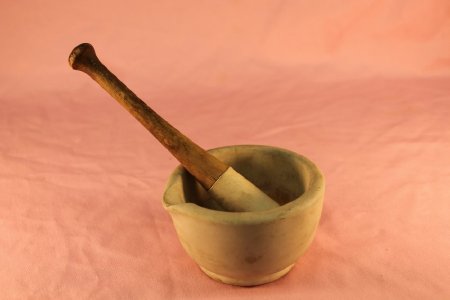
- Mortar & Pestle
- PH307
-
- Early 19th century mortar and pestle. Ceramic mortar with porcelain and wood pestle. Upper lip has pouring spout molded into it. The bottom of mortar has a seal that is illegible but the words TRADE MARK are visible.
The pestle is long for the mo... View Full Record
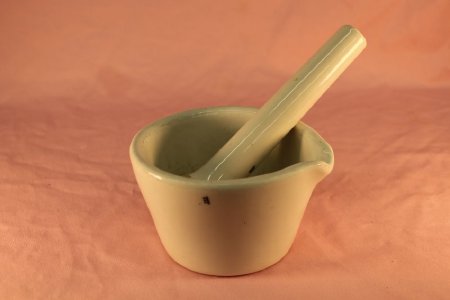
- Mortar & Pestle
- PH308
-
- Ceramic mortar and pestle. lip of mortar has a pouring spout molded into it. pestle is one solid piece of glazed ceramic. Both mortar and pestle have a makers mark; COORS USA
... View Full Record
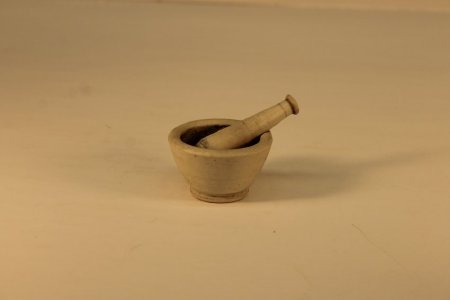
- Mortar & Pestle
- ph355
-
- Small mid 18th to early 20th century, unglazed, ceramic mortar & pestle. The small size indicates this may have been used as a travel mortar & pestle by a doctor, used to mix medicines for dispensing during house calls... View Full Record
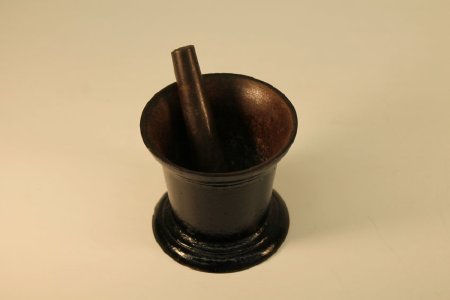
- Mortar & Pestle
- ph356
-
- Cast iron mortar & pestle. This style of mortar & pestle first appeared just prior to the civil war and was used until the turn of the century.... View Full Record
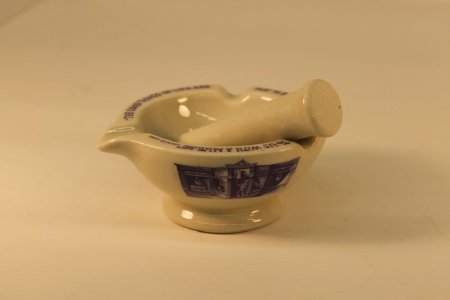
- Mortar & Pestle
- ph357
-
- Ceramic mortar & pestle. This item was given as an advertising piece to pharmacists in the 1950s. The mortar is printed with pictures of early pharmacies on the sides. Along the tip rim it reads The good things in life are not to be had singly bu... View Full Record
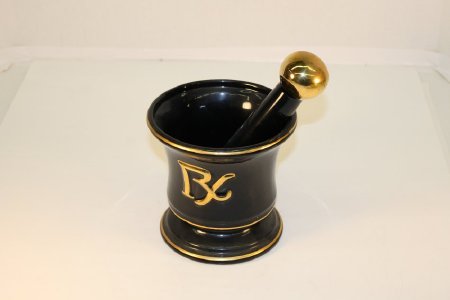
- Mortar & Pestle
- ph358
-
- Display ceramic mortar and pestle made by Blair specialties. Made in the 1950s, these mortars and pestles were display items for pharmacy windows. Black with gold trim.... View Full Record
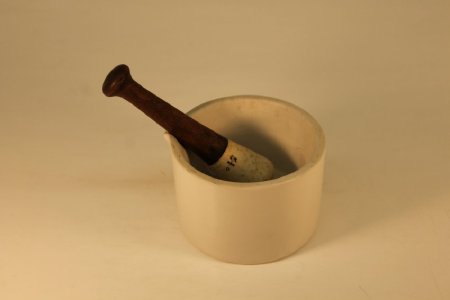
- Mortar & Pestle
- ph360
-
- This early 19th century mortar is made from white ceramic with a ceramic and wooden pestle. The sides of the mortar are straight rather than the typical curved bowl. The combination wood and ceramic pestle indicates it was manufactured in the early... View Full Record
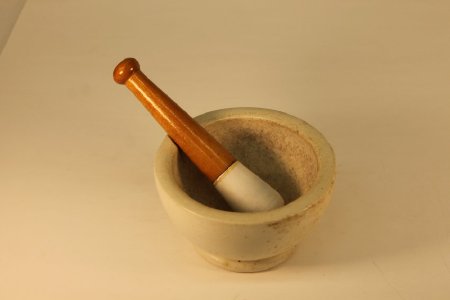
- Mortar & Pestle
- ph361
-
- This early 19th century mortar is made from white ceramic with a ceramic and wooden pestle. The combination wood and ceramic pestle indicates it was manufactured in the early 19th century.
... View Full Record
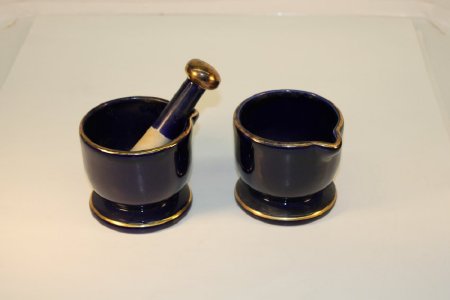
- Mortar & Pestle
- ph359
-
- Mortar and pestle set with two mortars and one pestle. Made from blue glazed ceramic with gold trim. These were made by Blair Specialties in the 1950s and used as display pieces in pharmacy windows or shelves.... View Full Record
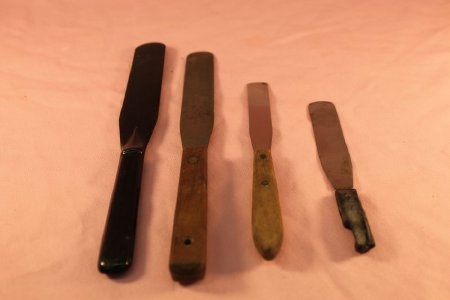
- Spreader
- PH310
-
- Set of 4 early to mid 20th century spreaders. These are used by the pharmacist for both mixing ingredients for dispensing as well as counting out tablets for dispensing.
2 of the spreaders have wooden handles, 1 has a bakelite handle and the fo... View Full Record
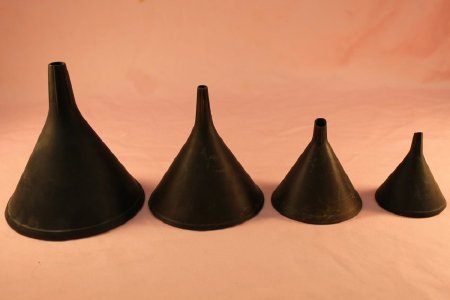
- Funnel
- PH311
-
- Set of 4 funnels. Small to Large with narrow ends to fit into medicine bottles.
These funnels are made from bakelite, and early 20th century form of plastic.
Used by pharmacists to fill bottles with liquids.
There are no marking on any of the... View Full Record

- Pestle
- PH312
-
- Hand blown glass pestle. Used by pharmacist to grind herbs and other ingredients. Top of pestle flat where cut from molten glass.... View Full Record

- Kino Jar
- PH337
-
- 19th century ceramic pharmacy jar with lid. Jar is labeled KINO and includes hand painted leaves and crown in blue and gold. Bottom of jar is labeled Kr. I 250, Bogen Germany. Lid of jar is rimmed in gold. The glaze on the jar shows extensive cra... View Full Record
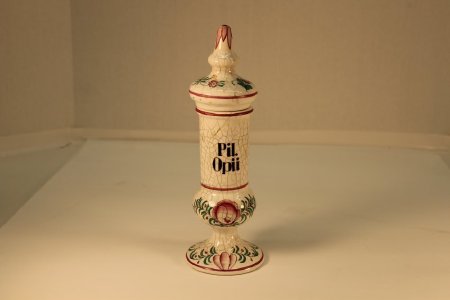
- Pil. Opii Jar
- PH338
-
- Ceramic jar labeled Pil. Opii. Hand painted with floral and leaf design in pink and green. Bottom of jar labeled A H Germany.
Pil. is the Middle Ages abbreviation of pills. Opii is the Middle ages abbreviation for opium.
19th century pharm... View Full Record

- Pill Roller
- PH339
-
- Wooden and brass 19th century pill roller. This is used to form powdered and ground herbs and drugs into pills.
After grinding ingredients with a mortar and pestle, the pill roller is used to form the pills for dispensing.
... View Full Record
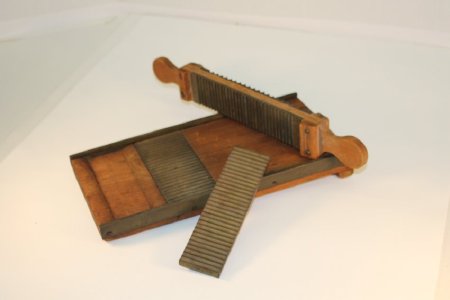
- Pill Roller
- PH340
-
- Wooden and brass 19th century pill roller. This is used to form powdered and ground herbs and drugs into pills.
After grinding ingredients with a mortar and pestle, the pill roller is used to form the pills for dispensing.
This pill roller inclu... View Full Record
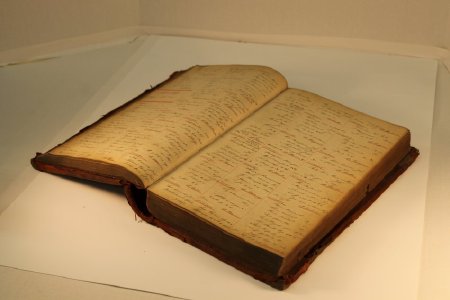
- Pharmacist Log Book
- PH341
-
- Leather bound book containing pharmacist recipes and doctor prescriptions. All of the entries are by date and include the medicines, dosages and prescribing doctor.
The dates range from July 17, 1807 to December 28, 1807.... View Full Record
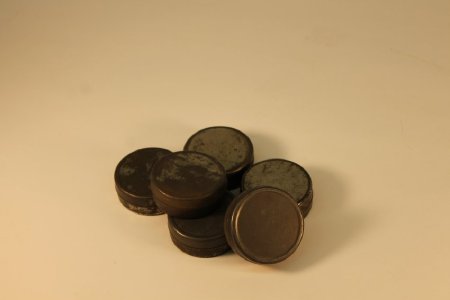
- Pill Tin
- PH342
-
- 19th century round white metal pill tins - the collection includes 16 pill tins
Pharmacist would attach his own label with dosage and instructions.... View Full Record
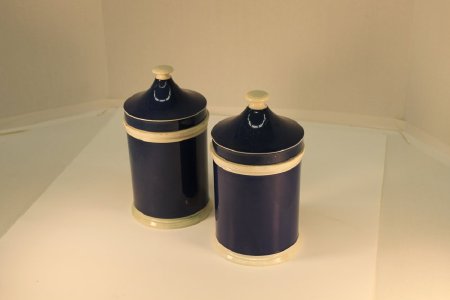
- Ceramic Canister
- PH343
-
- Set of two ceramic pharmacy canisters. These canisters are made from pearlware ceramic indicating they were manufactured no later than 1820, when pearlware was no longer made.
18th and 19th century pharmacists used canisters such as these to st... View Full Record
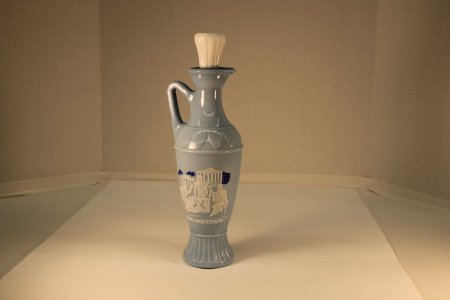
- Decanter
- PH344
-
- Late 19th to early 20th century pharmacy ceramic decanter. Light blue ceramic with depiction of Socrates and Plato on two sides. Includes a white ceramic and cork stopper.
Decanters such as these were largely decorative and used to dispence va... View Full Record
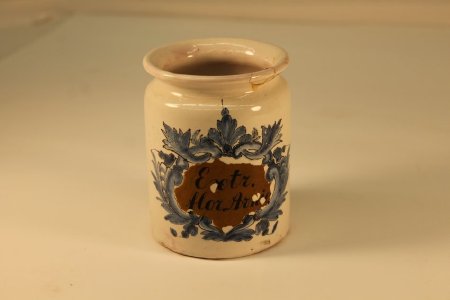
- Extract of Arnica
- PH345
-
- 19th century ceramic jar labeled Extr.Flor. Arnic. with hand painted blue floral design.
The extract of the flower Arnica was used in the 19th century to releive strains and sprains as well as reduce bruising. Today, it is still used by athletes.... View Full Record
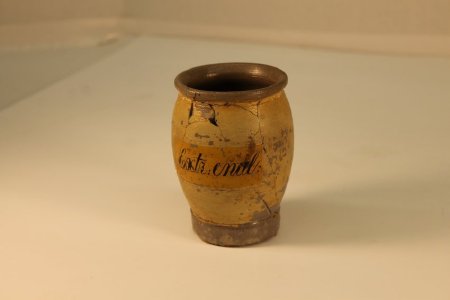
- Extract of Enul Jar
- PH346
-
- 19th century clay jar labeled Extr. enul.
Hand made clay jar painted yellow, typically used by pharmacists containing balms or ointments for dispensing.
The jar has been extensively repaired and the yellow paint is worn and chipped... View Full Record

- Suppository Mold
- PH333
-
- This is a 19th century brass suppository mold, made in London. I has three pieces, the main body, the top and a screw to secure to 2 other parts. There are 12 mold holes. The word London is slightly legible on the top along with a GR indicating gr... View Full Record
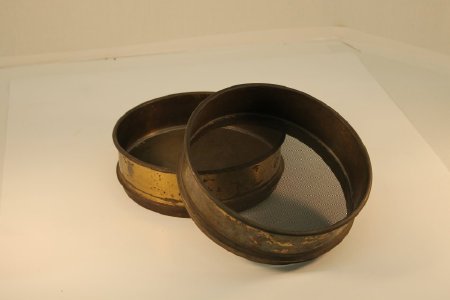
- Sifter
- PH349
-
- Set of 2 19th century brass pharmacy sifters.
Sifters were used in the early 19th century for sifting herbs in preparation to dispensing to patients.
Each screen has a different diameter screening. One is marked 20 and the other is marked 60, w... View Full Record
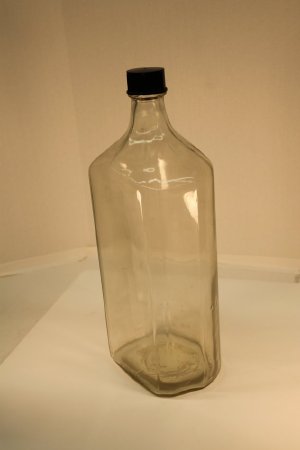
- Display Bottle
- PH351
-
- Large display pharmacy bottle. Clear mold blown glass with bakelite screw on top. These large bottles were used much like show globes to attract attention to the pharmacy from the front display window. They are usually filled with colored liquid a... View Full Record

- Cresolene Burner
- PH350
-
- Late 19th century cresolene burner the base and stand are made of cast iron that has been painted gold. The glass bowl at the bottom is marked VAPO CRESOLENE KEROSENE.
The lamp cover is missing. Along with the burner is a copper bowl with a long... View Full Record
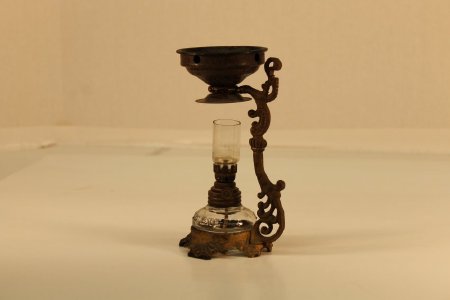
- Cresolene Burner
- PH352
-
- Late 19th century cresolene burner the base and stand are made of cast iron that has been painted gold. The glass bowl at the bottom is marked VAPO CRESOLENE KEROSENE. The burner includes the glass globe that fits over the flame as well as the tray... View Full Record
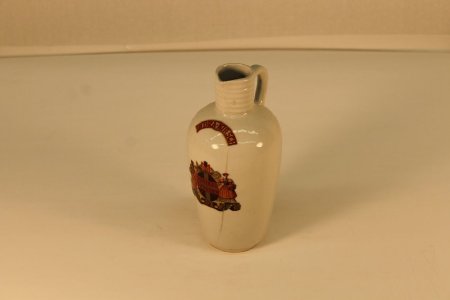
- Decanter
- PH353
-
- Late 18th early 19th century German congac decanter. Company seal reads MACHOLL MUNCHEN.
Although not included with this one, these decanters were usually sold with a small cup for serving the congac.... View Full Record
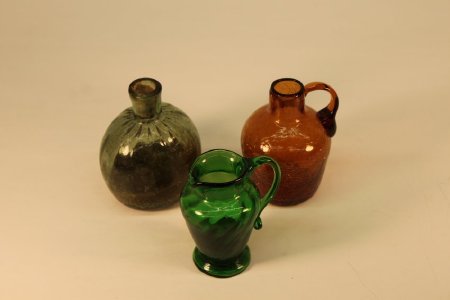
- medicine bottles
- PH354
-
- Set of 3 mid to late 18th century medicine bottles. All 3 are mouth blown glass with pontil marks on bottoms. 1 amber glass, and 2 green glass
During the 18th century, this type of bottle was used to store and dispence liquid medicines with a co... View Full Record

- Suppository mold
- ph362
-
- White metal blend suppository press with three mold. The side of the press reads APPLEBAUM SUPPOSITORY MACHINE MFD BY DRUGGISTS APPLIANCE MFG. CO. FORT RICHMOND, N.Y. PATS PENDING.
The Applebaum Suppository Machine was patented in 1924 so this ex... View Full Record
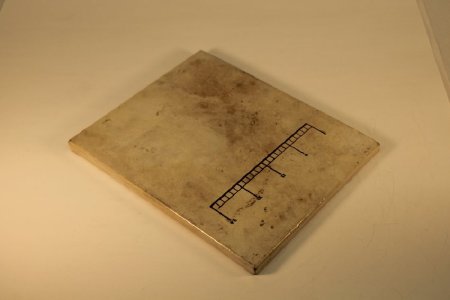
- Pill Counting tray
- ph363
-
- Marble pill counting tray. The tray includes an imprint of a scale from 1 to 24 for dispensing pills. This type of tile was used from the late 19th century to the early 20th century... View Full Record
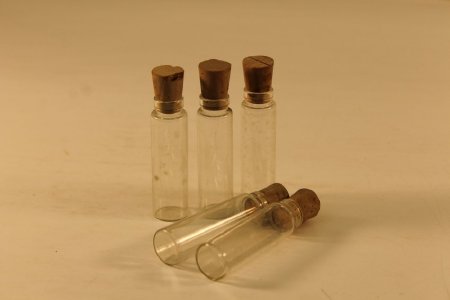
- Pill Bottles
- PH364
-
- 19th century clear blown glass pill bottles with cork stoppers.
Used by pharmacists for dispensing pills... View Full Record
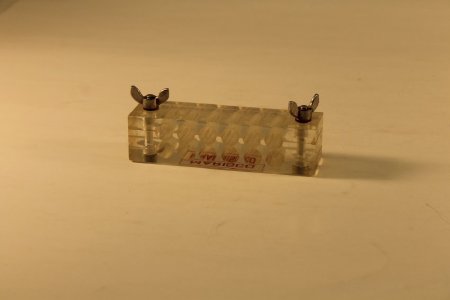
- Suppository Mold
- PH365
-
- Mid 20th century suppository mold made by Marisco. Mold consists of three translucent plastic pieces attached with metal rod and wing nuts. 12 slots for bullet shaped suppoitories.... View Full Record
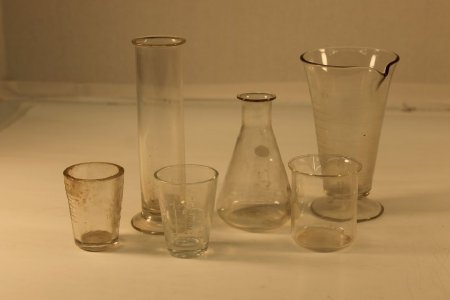
- Graduates
- PH366
-
- Assortment of clear blown glass pharmacy graduates. Markings for ounces, teaspoons, and tablespoons.
Used for measuring liquids for dispensing.... View Full Record










































